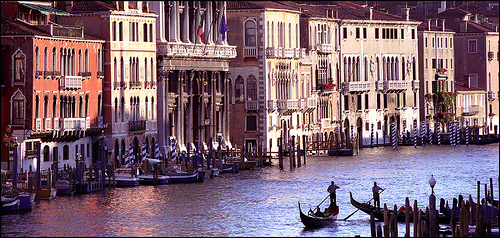
Greetings from Italia ~ Tuesday, November 16, 2010
Dear Readers,
It is with a somewhat heavy heart that I begin this last missive from the Colby-Sawyer Italy extravaganza. I am not sad because I am sitting on the tarmac at Venice's Marco Polo Airport, already delayed two hours and expecting another two hour delay. No, that is all because of heavy fog at Heathrow and it would be unfair to blame that on British Airways even if they are English. One traveler on our flight (but not in our group) has already left the plane in a huff. She apparently thought conspiracy theorists were at work and that the fog was merely a ruse to delay our progress. I am more of a naturalist who sees fog for what it is – fog. Except, of course, in New London, where I know that I am never in fog but occasionally lucky enough to be living inside of a cloud. No, friends, I am sad because we are leaving Italy and our group will soon disperse, taking good memories and new friendships with us. While the trip will be over, we will always have Italy.
When I last wrote to you we were on a bus traveling away from Cortona and on our way to Bologna and then onto Venice. Bologna was fascinating – it is the home of the oldest university in the world, dating to 1088, although one of our group recalls being in other cities and countries that make the same claim. She distinctly remembered Morocco. Be that as it may, the western university – which means association of students – traces its origins to Bologna. Bologna remains the seat of one of the world's greatest universities and the EU's higher educational reform takes its name from Bologna. Our city guide in Bologna, Giacomo (William in English), informed us that we were in Bologna on the equivalent of Italy's Thanksgiving. We were in the cathedral at the end of a mass blessing the region's farmers, many of whom were present, wearing yellow kerchiefs. The occasion also explained why all those big tractors were parked outside the church.
From Bologna we drove to the edge of Venice where we bid adieu to our coach driver, Romano, and to our coach. We then boarded water taxis for Venice.
What can I say? Everything we had seen up to Sunday evening was fabulous. But there is only one Venice and the city charms me. If you have been there, you know. It is a city of water, islands, bridges, towers, churches, restaurants, glass, lace, and art, art, art. Venice assaults the senses, the spirit and the mind. At one time it was one of Europe's most populated and powerful cities or states. Its population has dropped to about 60,000 – it is simply too expensive a place for young people to live. Its power has ebbed – its ships were smaller than those of the English and Spanish; the rise of the Ottoman Empire challenged it; and finally, there was the storm that was Napoleon. But its beauty, mystery and magic persevere.
Beauty – St. Marco's Square; the Doge's palace (the Doge is a duke —he was the leader of the state but was essentially a figurehead and often a very senior statesman); the Basilica with its sparkling mosaics; the tower; the Rialto; the Church of St. Rocco; the Peggy Guggenheim Collection; L'Accademia; the Lido; and on and on and on.
Mystery — Carnival with all those masks (the masks with the long noses were based on the masks doctors wore during the plague – the noses were filled with various aromatics thought to protect the doctors); the small narrow streets once you get off the main ways – follow one to another major way but follow another to a dead end or to a canal; the life span – Venetians have very long lives and always have – the average age of the citizenry now is somewhere in the 60s — it must be all that fish, all that olive oil, and all that wonderful wine.
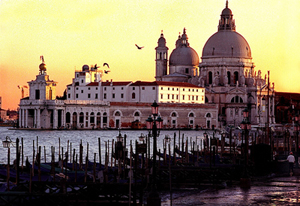
Magic – poof. Venice enchants. Whatever it has inspired Shakespeare to set two large parts of two of his plays there: Othello and The Merchant of Venice. Last night I was running along the Giudecca Canal and there was a heavy fog. As I moved along I heard the low sound of a ship's fog horn and when I looked out at the water I saw lights and realized a cruise ship was being towed along. I felt like I was in Fellini's “Amarcord” when the boats from the village go out to view the ship. And then I jogged back to the hotel.
This was my second time in Venice and I plan to return. Both times I have had trouble leaving. The first time we water taxied to the airport in a terrible thunderstorm and then were delayed as a result of that same storm for two more hours.
Today it is the fog in Heathrow as well as the rain here. Is it a sign that I am leaving too soon? Certainly Othello and Desdemona left Venice too soon. Perhaps if they had never traveled to Cyprus they would have lived on as one of drama's great couples instead of one of its most tragic. But then again, dear readers, one can stay too long in Venice, as the protagonist of Thomas Mann's short story “Death in Venice” proves. Better to leave too early, perhaps, than stay too long.
And so, our trip comes to an end, and I bid you and my traveling friends adieu.
Your intrepid correspondent and president out linking to the world and signing off,
Tom
Greetings from Italia ~ November 14, 2010
Today it is Sunday in Italy.
Contrary to popular belief, even though Italy is the home of the Pope, most Italians are more likely to spend Sunday in the cafe or trattoria than at Mass. Your humble reporter expresses no judgment on that fact but merely passes it on.
Now, whether they go to church or chow (very weak wee pun there) they must move. I wrote about movement in Italy the other day so, dear reader, please forgive me for returning to that theme and let me tell you about Saturday, Nov. 13 because return to the theme of movement I must.
Movement can be a type of change, and as I have been wont to say, change is inevitable. But some movement isn't anything but pointlessly going from point A to point B and maybe even back again. My first "vignetti" (Galligan Italian for vignette) may be that type of movement. It may even be stereotypical, but I attest that it comes from my eyes and ears to my BlackBerry-tapping fingers to your eyes. I report it as I saw it and heard it with maybe one or two authorial intercessions.
You will recall that we are traveling by coach. You will also recall that we have been staying outside Cortona in the Tuscan countryside (and yesterday we were even under some Tuscan sun). You will also recall that our coach driver is named Romano. You will not recall that he is reading Crime and Punishment because I did not tell you that until now. No stereotype there.
Allora (an Italian throat clearing word that means now then or okay or now we are ready), Romano cannot get the coach down the drive to our villa because the driveway is too steep and too narrow. Consequently, Romano lets us off and picks us up on the road at the top of the hill – near a blind curve. As he drops us off and picks us up he nervously watches for cars. The safest place for him to get us in or out entails him blocking the villa's driveway and almost but not quite blocking the driveway of the house next door.
As Romano said: It is very difficult.
Indeed, it requires a driver of great skill and Romano is exactly that.
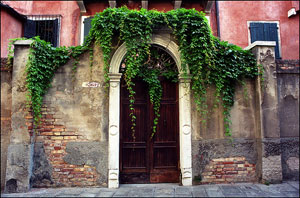
Last night as we boarded the bus the inevitable happened. No, no one was hit by a car. But the neighbor came home. And he approached from the back of the coach, meaning he had to drive by us and then perilously turn left in front of the bus and into his drive.
Our neighbor did not let the event pass without comment. He got out of his car, walked up to Romano and began to talk. I was in the bus so I could only see and could not hear. Our neighbor continued to talk. Finally, Romano found the chance to offer his own opinion of the matter. I could not swear under oath that our neighbor and Romano were on common ground.
Soon both men were talking at once. Their mouths were opening wider. A hand went into the air. Then another. Then the neighbor threw both his hands into the air. Romano replied in kind. Our neighbor shook his head. Romano shook back. Our neighbor shook his head and threw his hands in the air. Romano paused and then, as if he were on "Dancing with the Stars," he pirouetted away from our neighbor and pirouetted right back and delivered what looked like an aria of reasoned elaboration.
At this point our neighbor's partner appeared on the scene to pull him away. Marco, our tour guide, also joined in the festivities. Even the neighbor's dog wandered over with its little tail wagging away.
Things calmed. Hands still moved but much less dramatically. Our neighbor pointed behind the bus. Romano pointed ahead of the bus. The partner walked away. Marco nodded. The neighbor shrugged his shoulders got into his bar, backed into the road faster than he had driven in, and took off.
As Marco boarded the bus, my curiosity overcame me and since I am not a cat, I asked, "What was that all about?"
Marco sighed. "Signor," he said, "we were merely discussing the options for drop-off and pick-up at this hotel."
Allora. Not sure that story is about good change or just verbal movement, but I have another.
Yesterday we visited a villa, hotel and winery originally built in the 1300s. Things went well for the family that owned the land until the 1500s when two of its members – two brothers – became convinced that Martin Luther was right and became Protestants. Religion again. Well, during the Italian Inquisition, conversion to Protestantism could lead to problems – anything from losing your property and spending time in the hoosegow to being burned at the stake. You might say it was a “hot” topic.
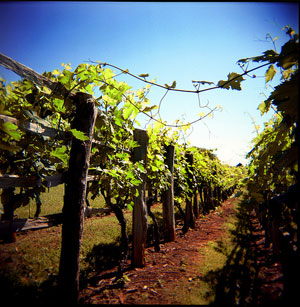
The brothers, rather than going from the sautee pot to the fire, left the area. The remaining siblings did what any close family would do then or now. They disclaimed their brothers, disavowed their beliefs, called them fools or worse, and maybe used some of those gestures our neighbor was kind enough to show us to describe their brothers.
But it was all to no avail. The church and/or state took the land from the Catholic siblings. It was guilt by Reformation and association.
Over the years the property fell into disrepair. The fields lay fallow. The buildings sagged and crumbled. Then in the early 1900s an heir of the former owners – the religiously diverse family – repurchased the place and turned it back into a working farm. Over the years rooms were added. And in 1998, Mrs. Donatella, the great-granddaughter of the repurchaser, inherited the spread.
Mrs. Donatella decided to make some wine. She planted some more grapes and waited. She then went looking for a vintner or two. She discovered that hiring an experienced vintner was almost as expensive as acquiring a power hitting outfielder in free agency.
So next Mrs. D. turned to the University of Siena to hire a recently minted graduate who had studied the science and art of winemaking. The head of the department told her that all the graduates or soon to be graduates already had jobs with leading wineries. It was a little like all those graduates from elite schools running off to work for someone like Lehman Brothers.
"They all have jobs?" Mrs. D. asked in disbelief.
"Yes," replied the head man.
"All?"
"Well," the head man paused. "All the men."
You see, it seemed something was going on. It is something we Americans know all about, too: bias and discrimination. The Italian wine industry did not believe women could be great vintners. Even though they could major in wine, they could not get top jobs as vintners. The old wine glass ceiling.

At that moment Mrs. D. decided to hire two female vintners and create the only winery at which women oversaw and implemented all production. How has it turned out? Pretty darned well. Just a few years ago the winery was honored as a winery of distinction and the next year Mrs. D.'s brunello was voted the best in the world. If you want to taste it, stop by some day. We thought it was so good we bought a case.
Allora, a salute to equality and positive change.
Speaking of change, it is time for us to move on. Our itinerary for today in Italy is:
Depart for Venice, stopping en route in Bologna. A guided walking tour of the center, virtually untouched since the Renaissance, highlights specialty food shops for an opportunity to sample the local wares. Continue toward incomparable Venice, built on 117 islands with 150 canals and 400 bridges.
Your intrepid correspondent and president still out linking to the world and signing off,
Tom

Greetings from Italia ~ November 12, 2010
Hello from Siena.
I promised more on art …
Imagine being a student in an art history class in Florence and being able to walk down the street to see Michelangelo's David or the Duomo (cathedral). And then imagine that when you go to Venice and see a Tintoretto you can say, “Hey! I studied that in class and now I really see it. The colors are so alive.” In Italy, art and architecture are all around us.
In Florence some of us visited the Galleria dell'Accademia, the famous home of Michelangelo's David since 1873. We had already seen copies, the most famous of which is in the Piazza della Signoria in front of the Palazzo Vecchio. We saw another copy being placed by cranes at the Duomo's roof line, which was apparently Michelangelo's intended spot for his sculpture. The City leaders and church did not go for it, however. Perhaps the sculpture was too heavy, or perhaps it was just too realistic in its depiction of the unclothed hero/prophet/poet. There is yet another copy south of the Arno River in Piazzale Michelangelo, standing high above Florence and looking over the city's skyline: the Duomo, the Ponte Vecchio, the Palazzo Vechhio.
In any event, the original is unparalleled. As my friend and colleague Professor Chris LaBarbera says, it gives you chills. David stands 17 feet tall at the end of a long hallway. He stares off meditatively to his left. If you stand in certain place he stares directly into your eyes with his wide pupils full of distant determination. Is he about to meet Goliath, as my spouse Susan thought, or has he already accomplished his epic feat and is contemplating both what he has done with the assistance of his God and what it means for him and his people. Is he already composing his famous song, having been guided on his path of righteousness?
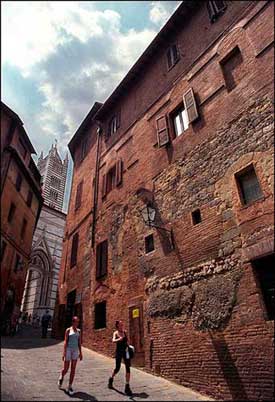
His barely visible sling is draped across his back. His marble veins seem to pulsate. His ribs poke at his side. His muscles are those of a world-class athlete. David's head and hands seem larger than his body, and of the many theories that explain this issue of scale, perhaps it is Michelangelo's commentary on the power of reason and creation through mind and hand.
Michelangelo, only 26 when commissioned in 1501 to create a monument expressing Florence's Republican pride, believed that the marble contained the sculpture inside it. Once the sculptor selected the proper stone it was then his task to free the figure within. We heard that Michelangelo signed commissions for numerous sculptures and did not fully deliver. Maybe it was just bad stone.
At convocation this fall, I spoke about guides and the role of guides in one's life. I talked about the faculty's role as guides and here I learn that even the great Renaissance artists had guides. While Michelangelo, Leonardo, and their peers restored classical realism to art and religious art, the generation before them pioneered the trend. Giotto painted Jesus as a man suffering, not as a smiling God. Pizzano did similar things with marble in the 1300s. The Renaissance artists took their guides' work to new expressive levels.
Much of the art we have seen has a sacred theme. Much of it is Christian, however, the Basilica di Santa Croce in Florence, whose bells our students hear as they hurry to class, has a blue star of David (same guy!) because the Jewish architect wanted to emphasize the Judeo-Christian tradition, not simply the Christian. As we near Venice we will notice some Eastern themes as well. Ah, the value of diversity.
Here in Italy we also see how space matters. In Siena we saw a fantastic cathedral built over eight generations with no architect! Black and white marble pillars support it, leading some to think of the Moors and others to think that a former headhunter was in charge of decorating: 172 scowling heads of popes peer down as you enter. The age and beauty of Nicola Pisano's 1268 pulpit is inspiring. For silence and awe, Bernini's chapel is amazing. It is small, rounded, but full height with a dome. Two angels peer over the edge at you, and at the top is a golden sun. Attention is focused on a fresco of Mary and Jesus, both adorned with thin jeweled crowns. The monk statue to the left is friendly and kind looking, as if, improbably, he's going to ask you to dance. It is simply a beautiful space. Our guide described the building in great detail but at the end put her hands out at her sides with her palms skyward and sighed. Did you feel it? Did you just feel it? Si. I felt it.
Friends, Italy is a celebration of the arts – the beautiful, the tragic, the sacred, the profane, the known and the unknowable. It is our right as humans to experience art. Without it we are worse than poor. It is our duty to explore, experience, and support the arts. We must save the planet but part of saving the planet is saving the arts. We must educate our students and our children in and about the arts. We should urge them to create. Those friends are the reasons why a new inspirational arts center is critical for our college. You'll hear more about that at another time.
Ciao, your intrepid correspondent and president out linking to the world's art,
Tom
Greetings from Italia ~ November 11, 2010
Hello from Tuscany.
Thursday we drove from our Villa Aurea, an acclaimed anti-stress and wellness center in the hills, to Florence. Florence is located on the Arno River, and the most famous way to cross the Arno is the Ponte Vecchio. In days of old, butcher shops lined this medieval bridge and butchers threw the offal into the river – definitely not living sustainably, especially for those down river. The odor was terrible. Today jewelry stores sit where the butchers formerly plied their wares to Florentine carnivores. Do the jewelers throw their unsold gems into the river? Sadly, no, but they do bargain.
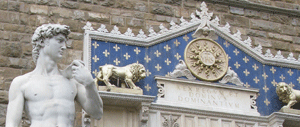
Florence is also the home of the famous Duomo of the Basilica di Santa Maria del Fiore and the Uffizi Gallery, one of the world's great museums. It was once the home of the Medici – Florence's ruling family during the Renaissance – and the place where Niccolo Machiavelli wrote The Prince in an effort to ingratiate himself to the Medici.
Today Florence hosts thousands of international students who spend a term or an entire year studying and living in the city. Go for a walk along the Arno and you will see runners in Amherst, Stanford, NYU and other schools' T-shirts. And, for the second year in a row, that runner might be wearing a Colby-Sawyer shirt because Florence is one of the homes of our Global Beginnings/Global Explorations program (Strasbourg, France is the other).
This fall Colby-Sawyer has 15 first year students living and learning in Florence under the tutelage, leadership and guidance of Professor of Humanities Chris LaBarbera. Chris is a philosopher both inside and outside the classroom, and he is also a wonderful and gracious host, as we found out yesterday when we visited.
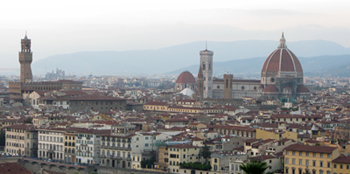
Chris met our travel group of alumni and friends and walked us through the city to the site where Colby-Sawyer classes are held. There we met the students who hail from New England, California, China and a number of other places. We joined them for a five-course lunch at one of the ristorantes they frequent – molto buono.
We heard a lot about life as a foreign student in Florence, including the challenges. One, clearly, is balancing school work with the opportunities of living in such a magical city. Another is simply adjusting to college since the group is all first year students. To address that, next year we will send sophomores to Europe instead of first years.
All our students live in apartments located in the same area of the city, about ten minutes from the academic site. Many of the students were not used to cooking for themselves so there were classes on campus before they left that covered everything from how to boil water to how to make ravioli. Some students now brag about their cooking while others specialize in locating reasonably priced restaurants.

Students take classes Monday through Thursday in ethics, Italian culture, animal rights, Italian culture, art history, and writing. The long weekends are free for study, travel and cultural activities. Already they have been all over Italy, from Naples to the Cinque Terre; Spain, England, the Czech Republic, Germany, and beyond.
One of the benefits of traveling is learning about the world. That is what this alumni trip is all about: lifelong learning. That is what Adventures in Learning at Colby-Sawyer is all about, too. Our time with the students in Florence was all about learning, even if the learners might have been at different chronological points in their lives.
It quickly became apparent that from an educational perspective one of the highlights of studying in Florence is the ability to walk outside the classroom on a five-minute field trip and see where history was made. The art history professor can pause the lecture and say, "Let's go look at that!" Imagine studying art history in Florence. Art ... more on art tomorrow, which will find us in Siena and the hilltop town of San Gimignano.
Your intrepid correspondent and president out linking to the world,
Tom
Greetings from Italia ~ November 10, 2010
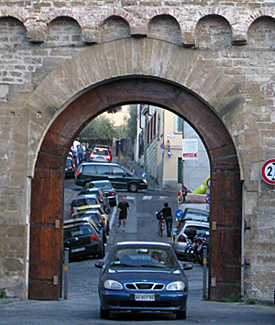
Perfetto is the only word to describe our trip to Italy with our Colby-Sawyer alumni friends. We have heard about a little rain and fog, and even rumors of hail, but have moved through all those rumors with smiles and ease, and slightly damp pants cuffs. Grazie for our Italian umbrellas.
Today, Nov. 10, we drove to the city of Lucca, which is surrounded by 16th century Renaissance walls. Moving around Italy is not quite like moving around at home. Here we do not jump into our big cars and drive to a shop or get on the interstate to zip to Boston. If we had a car here in Italy it would be very small, as the streets are certainly smaller. The A1 which runs north and south from Milan to Napoli is narrower than New Hampshire's Route 93. Most of the city and country roads are very narrow by our standards, as well. Cars passing cars is an adventure. Cars passing pedestrians is no less dramatic an event. And yesterday, Susan and I were walking in Lucca when a van came by without slowing. Susan and I scampered for doorways against which we pressed our threatened selves. As the van passed, my jacket brushed the side view mirror. Another bruschetta at lunch and I might not be maintaining this correspondence.
Another reason for small cars is that gas is 1.40 euro per liter. What does that mean? It means almost $8 per gallon. Small cars use less gas and save money. So in this case, living sustainably is also living economically. By the way, Fiat now owns Chrysler.
How are Italian drivers? Fast. And they expect American joggers, as well as walkers, to get out of the way. At the same time, they have stopped for us at crosswalks with smiles and waves. Know the rules and presume the driver has the right of way, and you'll be fine.
We have also seen cyclists and a beautiful bike lane along the coast in Sestre Levante. But we have seen no bicycle thieves – a little reference for you fans of Italian neorealism films.
While our group generally moves about by foot or coach, we have also ridden the train and the bus. If you ride the bus, make sure to validate your paper ticket. One New London friend wondered why, if we have a paper ticket, do we need to validate it? Our son Patrick had the answer: So you can only use the ticket once and not get hauled away by the carabinieri. I am not sure our friend was convinced, but he did validate his ticket.
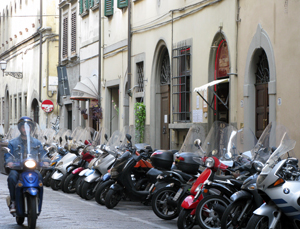
When we are on the coach, we all sit back and relax – except for Romano. Romano is our outstanding driver who gets us from place to place. While we admire the scenery, snooze or admire the goods we bought at the leather factory, Romano is at work. He winds around hairpin turns. He takes us into and out of tunnels by adjusting the hydraulics so we can squeeze through. He backs down hills and does K or U turns in spaces not big enough in which to get dressed. Romano senses our needs and brings us to clean, well maintained facilities. An aside on facilities: In Lucca, they were spotless. How? After every use showers automatically wash the room. The result: clean. The lesson: don't dilly dally unless you want a shower, too.
But back to Romano. We'd be lost, quite literally, without him. Yesterday we came around a sharp bend in a narrow road and came head to head with a typical small Italian car. We could not both go forward. What happens when a coach meets a car? You guessed it – the coach always wins.
Well, we have arrived in the Etruscan town of Cortona and will be here at our villa surrounded by beautiful Tuscan countryside for four nights. Thursday will find us in Florence, one of Colby-Sawyer's two Global Beginnings sites. I wonder if we'll see anyone we know there ...
Signing off, your intrepid correspondent and President still out linking to the world,
Tom
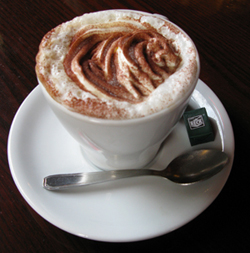
Greetings from Italia ~ November 9, 2010
Buon giorno -
Today, Nov. 9, our group of alumni and friends was on the Italian Riviera. We began in San Margherita, where pinot grigio was discovered by an American importer in 1979 and began its ascent to being the United States' most popular imported wine. Next stop: Portofino, a small, picturesque and very exclusive Ligurian resort town with a year-round population of about 495. We were there after the season, but the beauty stayed behind – go, and if you listen carefully, you will hear the whispers of the ghosts of Petratch and de Maupassant, as well as Richard Burton and Rex Harrison.
Then we were off to the Cinque Terre. These five villages perched on the edge of the sea, connected by the milk train out of La Spezia, did not disappoint. Beautiful multi-story buildings in pastel colors line cobblestone streets that lead to the sea. All around the towns are terraced hills in which residents grow lemons, olives and vegetables to pair with the fish they bring out of the sea.
In the Cinque Terre, if you are willing to climb a few hundred steps, you can see the world. The views explain why the ancient peoples of the Mediterranean decided to set sail to see the world – the water seems endless and you can't help but wonder what might be out there.
Our group of travelers ranges in age but everyone has participated in everything from climbing many, many steps to racing for trains and buses to sitting back to enjoy a cappuccino. One of our three pairs of sisters, we learned, last traveled for an extended time together in 1956 after the younger graduated from "Colby" and their family sent them to Europe on a grand tour. Now they are back, and they are going strong.
One thing we all do is eat. For breakfast there are fruits: melon, pineapple, grapefruit, even prunes. There are juices, breads, bacon, eggs, cereal, prosciutto, salami, yogurt, coffee that keeps you awake for days, tea, and for cheeses there is gorgonzola, pecorino, parmesan, Romano, and oh, I could go on!
After such a sumptuous breakfast (as described by Marco, our tour guide) we are so full we cannot eat again until a mid-morning pastry. A light lunch might include minestrone (with or without pasta), a salad, risotto, pasta (any of a thousand varieties) with meat sauce or maybe pesto (a Ligurian specialty), focaccia, a pizza, cheese, some sweet tidbit, and then an espresso.
After two meals like that it is no wonder we wait until about three for our gelato before dinner at about eight. Dinner!? Si, somehow we are always ready for dinner.
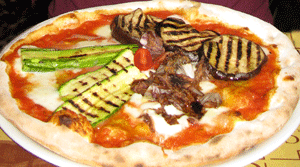
Last night in Sestre Levante we followed Marco's lead and went to Polpo Mario. Mario you know, but polpo, my friends, means octopus. Mario and the friendly octopus are depicted on the walls in a mural. Ask about it when you visit. Warning: the ending is not happy for the sea creature, but the endless supply of octopus is not so bad – we had a very nice warm potato and octopus salad. “What did the courting octopi say to one another?” the joke starts. “I wanna hold your hand, hand, hand” is the punchline, and we have to thank tour member and retired second grade teacher Pam from California for that bit of fun. After "octopi and potati" we had either ravioli with stock fish, spinach pasta with fresh tuna, or giant round noodles with mussels and clams.
After all that we had no room for il dolce – no souffle or chocolate cake with chestnuts, alas. Perhaps tomorrow night.
Well, after all that eating and all that octopus I am running out of ink ...
Buona notte, from your intrepid correspondent and President still out linking to the world,
Tom
Greetings from Italia ~ November 8, 2010

Last Friday, Nov. 5, the New London contingent of the Colby-Sawyer Italian Adventure left Compass Travel with Chris Hanson at the wheel and Holly Walker, our fearless leader from Compass Travel. At Logan International Airport we met other members of our group and collectively boarded a British Airways jet, stopping for two hours in London where we added a new friend, Holly's husband Luigi. Then we were off to Milano.
After a short bus ride we arrived at Stresa on Lago Maggiore and entered our five-star hotel. A movie was being filmed there, and after hobnobbing with the stars we wandered around the city and began the serious business of being in Italy – eating. Mangia!
Despite gray skies and a drop of rain, we had sunshine inside, to steal a phrase from our tour director, Mario. He is Italian but worked at Disney World, so he understands us.
As we get to know our group better we discover we have three groups of sisters, one of which is joined by their mother. Another consists of two Colby-Sawyer grads and the third is an alumna and her sister from the Midwest, combining to make 15 of us CSC and 8 who are soon converting.
Since arriving on Saturday we have been to Locarno in Switzerland, to Orta and to San Giulio Island to see the nuns (they were busy). Last night we supped and slept on top of a seaside mountain overlooking the Italian Rivera.
And there's been pasta, pasta, pasta. And a glass or two of vino.
Now off to our lecture on Italian hand gestures and then to Cinque Terre. More to follow, but it isn't too early for those reading this to plan for the next Colby-Sawyer alumni trip to Mexico.
Signing off, your intrepid correspondent and President out linking to the world,
Tom
Thomas C. Galligan Jr.
President and Professor of Humanities
tgalligan@colby-sawyer.edu


